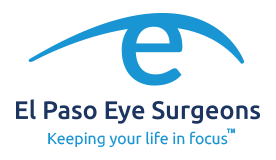Cataracts
Cataracts
Cataracts are one of the most common age-related eye conditions, resulting when protein cells clump together within your natural lens and block light entering the your eye, resulting in distorted vision. An up-to-date glasses prescription and ample lighting can help temporarily, but surgery is the only permanent solution. If you suffer from cataracts, El Paso Eye Surgeons can offer you outstanding surgical treatment using sophisticated techniques and intraocular lenses (IOLs) to restore your vision. Our advanced technology and experienced surgeons can safely restore your vision and improve your quality of life. Don’t wait any longer to overcome this treatable condition. Schedule a cataracts consultation with us today.
Your cataract is a lens inside your eye that is responsible for helping focus light from the outside world onto or close to your retina, which is the tissues the captures the light image like the film of a camera. Over time, your lens, which is clear when born, begins to harden, discolor and blur vision. A cataract is easiest described as being a dirty or cloudy window inside your eye.
Your cataract is surrounded by a clear bag, which is supported inside your eye with microscopic cables. When doing cataract surgery we create a small circular opening in the front part of the bag, use a special ultrasound probe to turn your cataract into fine soft pieces and carefully vacuum out the small remnants of the cataract out of the eye. Because your lens (cataract) is responsible for a significant amount of focusing power of the eye, we have to replace your removed cataract with a new lens. This new lens helps focus light as close to the retina as possible. Your distance vision will depend on how close light focuses to your retina and this is based on the lens power that is implanted into the eye (similar to the power or prescription of your eye glasses).
In the office, while checking for glasses we use your input as to which lens power allows you to see clearest, the test where we ask, “which is better one or two?”. Unfortunately, during surgery, we do not have the option of implanting a lens, asking how your vision is and trying different lenses in the eye. Instead, we use specialized machines in our office to take several measurements of your eye, which then calculate the power of lens needed to minimize your need for glasses at a distance as much as possible. Despite being very accurate and the most advanced technology available, there are still some instances where the measured lens power is a little too strong or a little too weak, which could lead a patient to remain a little near sighted or far-sighted and glasses may be needed to overcome this “refractive error” and allow for the clearest vision. Aside from the machine in the office, we can also use a special machine in the operating room to take additional measurements, which has been shown to enhance the accuracy of the lens power measurements, which can help minimize the strength of power for glasses after surgery.
The cataract surgery is done on an outpatient basis at and performed at an ambulatory surgical center. The nursing and anesthesia staff will spend time with you re-reviewing your medical history and prepare you for your procedure. Our anesthesia team will provide you with medicine in your vein to make you calm and relaxed and your eye will be fully numb with eye drops. Immediately following your surgery, we will tape a shield over your eye for protection. You will have an office visit the day after surgery and will re-instructed on your restrictions and how to use your post-operative eye drops. Restrictions are usually limited to light activity for one week. You will be prescribed eye drops to help prevent inflammation and infection, which will be used from 2-4 weeks depending on quickly inflammation resolves in your eye.
MONOFOCAL INTRAOCULAR LENS IMPLANT
The most commonly used lens implant is called a monofocal lens, which is the lens that is covered by all insurance plans. Monofocal means the lens focuses light for one distance and one distance only. In a vast majority of patients a lens power is chosen so that far away vision is a clear as possible with limited glasses, but vision at the intermediate (computer) and near (reading) area is quite blurred without glasses. So we typically say, patients will be fully dependent on glasses for intermediate and near activity. Your distance vision and need for glasses will be dependent on the residual refractive error as we discussed above. The monofocal lens assumes the eye is a perfect sphere and provides the clearest outcomes when an eye has minimal or no astigmatism. Astigmatism, which is when your cornea is shaped more like a football than a basketball (or perfect sphere), does not allow for light to focus to a single point and glasses may sometimes be needed to correct this astigmatism, when a monofocal lens is used. The more astigmatism the eye has, the stronger the glasses will be needed to achieve the clearest vision after surgery.
TORIC INTRAOCULAR LENS IMPLANT
There are specialized lenses called toric lenses, which help correct the eyes astigmatism and help the eye focus light closer to a single point on the retina and can reduce the need or strength of glasses for far away. Toric lenses do not always correct all astigmatism because there are gaps in the available strengths of lenses and sometimes your astigmatism falls in-between these strengths. Think of it as a show size. Lets say you wear a size 9 but a shoe is only made in size 8 and 10. You will have a shoe that covers your foot and allows you to walk on rough road much better than bare feet but the shoe does not perfectly fit your foot. But a pair of thick or thin socks can help that shoe fit better. In patients with a severe amount of astigmatism, glasses will absolutely be required to see at distance, intermediate and near. When compared to a monofocal lens, a toric lens can drastically reduce the need for glasses at a distance and sometimes allow for a patient to function without glasses for distance activities, BUT a small pair of glasses may still be needed for best vision.
MULTIFOCAL INTRAOCULAR LENS IMPLANT
When patients desire an extended range of vision to include some intermediate and near vision, multifocal lens implants can be used. Multifocal lenses use a technology that splits light so as light enters the eye some is used for distance, some is used for intermediate and some is used for near. These special lens implants are constructed with concentric rings on the lens, which is what allows for light to be focused at multiple focal points, as opposed to just one focal point as seen with monofocal lenses. We do not have a perfect lens that provides perfect vision for all areas of vision such that we can say you will be glasses free for all activities. There are different lenses available, which provide different strengths for the near (reading a book) and intermediate (iPad or computer) vision. Some lenses provide more intermediate than near vision, while others provide more intermediate than near. Our goal with multifocal with to implant a power of lens with would require the smallest possible refractive error (need for glasses) for distance vision, but enhancing the near and intermediate vision with the multifocal. Many times we implant the multifocal that gives more intermediate in one eye and the one that gives more near vision in the opposite eye, which provides an overall increase in the depth of focus when both eyes are open.
One important note to mention is that there are times (less than 1%) when the multifocal lenses do not provide any near or intermediate vision in patients. But, there are times that patients are able to perform all tasks without glasses because of the multifocal lenses, but we always say, YOU WILL LIKELY NEED A SMALL PAIR OF READING GLASSES, especially when performing fine activities at near (reading fine print, reading a menu in a dark restaurant, threading a needle). Also, the design of the multifocal lens can cause some patients to have glare and halos around lights at night time. Almost all patients have said they have become accustomed to these symptoms and area able to still function normally in dark settings. If the glare is too strong, the multifocal lens can always be exchanged for a traditional monofocal lens within the first 4-6 months after the initial cataract surgery. This is rare, and personally I have only had one patient in twelve years of practice that has required a lens exchange due to glare/halo issues.
- Your distance vision without glasses is dependent the power of lens we implant and how close light focuses to the retina. The lens power is determined by the machine measurement and patients can still require a small pair of glasses to achieve best vision
- Toric lenses can help reduce the amount of astigmatism your eye has and will provide better distance vision without glasses compared to a monofocal lens, but toric lenses may not correct all astigmatism and a small pair of glasses may be needed to refine your distance vision. A toric lens does not provide any near or intermediate vision and you will need glasses for these activities.
- Multifocal lenses do provide more near and intermediate vision than the monofocal lens, but the technology is still not perfect such that you will be guaranteed to be glasses free. Many still need a small pair of readers for fine print. The distance vision is similar to the monofocal lens, and provides more near and intermediate vision. Also, like the monofocal, some eyes still have a small residual refractive error, and a small pair of distance glasses may be desired or refinement with refractive surgery like LASIK to further minimize the need for glasses.
We hope this helps in your understanding of what your cataract is, how we manage your cataract and what options are available for lens implantation. Should you have any questions, please do not hesitate to contact us so we may address any concerns you may have. Having cataract surgery is elective and is only performed when your cataracts are interfering with your activities of daily life AND when you want it done. Leaving a cataract in place does not harm the eye so if you are happy with your vision you can leave them alone for as long as you desire. If you are bothered by your vision and glasses cannot make you see better, then cataract surgery is our only method for improving your vision (we have to replace that foggy window with a new clear window)
Thank you for taking the time and reading this and remember we are here to answer any questions.
Sincerely,
Mark J Gallardo, MD
Cataracts symptoms and Diagnosis

Vision loss is the most common symptom of cataracts. Typically this occurs very slowly, so patients may not realize they have cataracts until the condition has become advanced. Other symptoms can include:
- Glare
- Halos
- Difficulties with night vision
- Double vision
- Colors appearing less vibrant
Fortunately, cataracts are easy to diagnose. Your doctor may use a standard vision test, or a retinal or slit lamp exam to check your iris, lens, and cornea.
Cataract Surgery
By replacing a compromised crystalline lens with an IOL, your eye surgeon can help you to see more clearly. Depending on the IOL you choose, it may also reduce or eliminate your need for prescription eyewear.
During your surgery, the doctor will first administer a local anesthetic. He will then create a tiny incision, granting access to the lens. Next, ultrasound waves will break the clouded lens into tiny pieces. A special suction device will then vacuum the pieces out of the eye, through the incisions. Your doctor will then place the IOL. Performed on millions of patients every year, the cataract surgery procedure is extremely safe, while the recovery is fast and equally safe. You can expect to return to activity and work soon after surgery. For the first several days after surgery, you will need to avoid strenuous activities, and should use medicated eye drops for several weeks, as instructed by your doctor.
If you have cataract surgery performed on both eyes, your doctor will typically wait several weeks between the procedures. Thanks to advanced technology, patients who have undergone LASIK (link to lasik page) in the past can undergo cataract surgery without compromising the effects of refractive surgery.
IOLs
At El Paso Eye Surgeons, we offer these types of IOL:
- Monofocal: Monofocal IOLs provide vision correction at only one distance. With monofocal IOLs, most patients will continue to wear glasses after surgery.
- Multifocal: These lenses correct vision at varying distances, and can often reduce or eliminate the need for glasses.
- Toric: This type of lens can effectively treat astigmatism, a condition that results when your cornea is irregularly shaped.
Dr. Gulbas or Dr. Gallardo will discuss the various types of IOLs at your initial consultation and help you choose the lens that provides you with the greatest benefit.
Regain Your Clear Vision
If your vision has been compromised by cataracts, we can help you. Contact El Paso Eye Surgeons today to learn more about cataract surgery and schedule your appointment.
How to Achieve a Smooth Recovery
after Cataract Surgery
after Cataract Surgery
How to Achieve a Smooth Recovery after Cataract Surgery
After cataract surgery, it is common to experience blurry or cloudy vision as well as mild discomfort. It is important to rest for the first few days and avoid putting extra pressure on your eye. With proper care, most side effects should resolve within a week and your eye should be completely healed in one month. The team at El Paso Eye Surgeons in El Paso TX can provide you with detailed instructions to guide you through your cataract surgery recovery. We can recommend steps that will minimize your risk of complications and promote a speedy recovery.
Immediately After Surgery
Though surgery often lasts no more than 15 minutes, you should expect to rest in the recovery area for about 30 minutes to 1 hour for monitoring. You will need to arrange for a ride home, as the effects of anesthesia as well as impaired vision will hinder your ability to drive safely. When you leave the facility, make sure to wear sunglasses with UVA/UVB filters to protect your eyes from bright light.
During the healing period, it is normal for patients to experience:
- Redness
- Blurry or distorted vision
- Itching
- Mild discomfort
Most side effects should subside within a week.
To avoid developing an infection or injuring your eyes after surgery, you should take certain precautions. Make sure to cover your eye with a protective shield for a few days after the procedure. This can help to block irritants such as dust, dirt, bacteria, and debris. You should also avoid rubbing your eyes, and always wash your hands before touching your eyelids or under-eye area. Throughout your recovery, it is important to administer any antibiotic or anti-inflammatory eye drops as directed.
Make sure to wear sunglasses with UVA/UVB filters to protect your eyes from bright light.
Your doctor may prescribe antibiotic or anti-inflammatory eye drops, which can minimize your risk of infection.
Cataract surgery is a safe and effective way to improve eyesight. Almost 90 percent of patients experience a positive outcome and fewer than 2 percent have serious sight-threatening issues. Though rare, post-surgical complications can occur.
Be on the lookout for:
- Vision loss
- Persistent pain
- Bright flashes or floaters
- Excessive redness
If you experience any unusual symptoms, you should contact our staff ass soon as possible to schedule an appointment.

